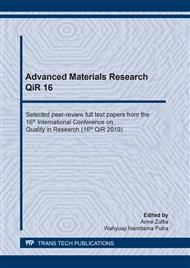[1]
S. Yeun and B. Kim, Electrochemical performance of activated carbon nano fiber with ZnO nanoparticles for Li-ion battery,, Synthetic Metals, vol. 210, p.386–391, (2015).
DOI: 10.1016/j.synthmet.2015.11.007
Google Scholar
[2]
M. Yoshio, R. J. Brodd, and A. Kozawa, Lithium-Ion Batteries Science and Technologies. Springer Science+Business Media, (2009).
DOI: 10.1007/978-0-387-34445-4
Google Scholar
[3]
Y. Wu, Ed., LITHIUM-ION BATTERIES Fundamentals and Applications. Boca Raton: CRC Press Taylor and Francis Group, (2015).
Google Scholar
[4]
N. Nitta, F. Wu, J. T. Lee, and G. Yushin, Li-ion battery materials: Present and Future,, Materials Today, vol. 18, no. 5, p.252–264, (2015).
DOI: 10.1016/j.mattod.2014.10.040
Google Scholar
[5]
R. J. Winter, M., & Brodd, What Are Batteries, Fuel Cells, and Supercapacitors?. Chemical Reviews,, (2004).
Google Scholar
[6]
N. Nitta and G. Yushin, High-Capacity Anode Materials for Lithium-Ion Batteries : Choice of Elements and Structures for Active Particles,, (2013).
DOI: 10.1002/ppsc.201300231
Google Scholar
[7]
A. L. Cazetta et al., NaOH-activated carbon of high surface area produced from coconut shell : Kinetics and equilibrium studies from the methylene blue adsorption,, Chemical Engineering Journal, vol. 174, p.117–125, (2011).
DOI: 10.1016/j.cej.2011.08.058
Google Scholar
[8]
A. Sholehah and A. H. Yuwono, The effects of annealing temperature and seed layer on the growth of ZnO nanorods in a chemical bath deposition process,, International Journal of Technology, vol. 6, no. 4, p.565–572, (2015).
DOI: 10.14716/ijtech.v6i4.1948
Google Scholar
[9]
T. Cebriano, I. García-díaz, A. López, and P. Fernández, Journal of Environmental Chemical Engineering Synthesis and characterization of ZnO micro- and nanostructures grown from recovered ZnO from spent alkaline batteries,, Journal of Environmental Chemical Engineering, vol. 5, no. 3, p.2903–2911, (2017).
DOI: 10.1016/j.jece.2017.05.052
Google Scholar
[10]
D. Deng, M. G. Kim, J. Y. Lee, and J. Cho, Green energy storage materials: Nanostructured TiO2 and Sn-based anodes for lithium-ion batteries,, Energy & Environmental Science, vol. 2, no. 8, p.818, (2009).
DOI: 10.1039/b823474d
Google Scholar
[11]
B. Scrosati and J. Garche, Lithium batteries : Status , prospects and future,, vol. 195, p.2419–2430, (2010).
DOI: 10.1016/j.jpowsour.2009.11.048
Google Scholar
[12]
N. Nitta, F. Wu, J. T. Lee, and G. Yushin, Li-ion battery materials: Present and Future,, Materials Today, vol. 18, no. 5, p.252–264, (2015).
DOI: 10.1016/j.mattod.2014.10.040
Google Scholar
[13]
O. Cevher, T. Cetinkaya, U. Tocoglu, M. O. Guler, and H. Akbulut, Preparation and electrochemical performance of ZnO films as anode materials for Li-Ion batteries,, in Acta Physica Polonica A, 2013, vol. 123, no. 2, p.355–357.
DOI: 10.12693/aphyspola.123.355
Google Scholar
[14]
N. A. Ahmed et al., Electrochimica Acta New insight into the mechanism of cathodic electrodeposition of zinc oxide thin films onto vitreous carbon,, Electrochimica Acta, vol. 94, p.238–244, (2013).
DOI: 10.1016/j.electacta.2013.01.103
Google Scholar
[15]
R. Shanmugam and W. Lai, Study of Transport Properties and Interfacial Kinetics of Na2/3[Ni1/3MnxTi2/3-x]O2 (x = 0,1/3) as Electrodes for Na-Ion Batteries,, Journal of the Electrochemical Society, vol. 162, no. 1, pp. A8–A14, (2014).
DOI: 10.1149/2.0201501jes
Google Scholar
[16]
M. Jing, F. Li, M. Chen, F. Long, and T. Wu, Applied Surface Science Binding ZnO nanorods in reduced graphene oxide via facile electrochemical method for Na-ion battery,, Applied Surface Science, vol. 463, no. July 2018, p.986–993, (2019).
DOI: 10.1016/j.apsusc.2018.09.038
Google Scholar
[17]
J. Li et al., Metal-organic frameworks derived yolk-shell ZnO / NiO microspheres as high-performance anode materials for lithium-ion batteries,, Chemical Engineering Journal, vol. 335, no. August 2017, p.579–589, (2018).
DOI: 10.1016/j.cej.2017.10.183
Google Scholar
[18]
D. S. Pambudi, R. Setiabudy, A. H. Yuwono, E. Kartini, J. K. Lee, and C. Hudaya, Effects of annealing temperature on the electrochemical characteristics of ZnO microrods as anode materials of lithium-ion battery using chemical bath deposition,, Ionics, (2018).
DOI: 10.1007/s11581-018-2723-z
Google Scholar
[19]
Y. Zhang et al., Nano Energy Sealing ZnO nanorods for deeply rechargeable high-energy aqueous battery anodes,, Nano Energy, vol. 53, no. July, p.666–674, (2018).
DOI: 10.1016/j.nanoen.2018.09.021
Google Scholar
[20]
H. Ning et al., Electrospinning ZnO / carbon nano fiber as binder-free and self- supported anode for Li-ion batteries,, Journal of Alloys and Compounds, vol. 722, p.716–720, (2017).
DOI: 10.1016/j.jallcom.2017.06.099
Google Scholar
[21]
B. Bhushan, B. S. Murty, and K. Mondal, A new approach for synthesis of ZnO nanorod flowerets and subsequent pure free-standing ZnO nanorods,, Advanced Powder Technology, vol. 30, no. 1, p.30–41, (2019).
DOI: 10.1016/j.apt.2018.10.004
Google Scholar
[22]
Z. Zeng, Y. Gao, S. Gao, S. Jiao, D. Wang, and J. Wang, Influence of different substrates on ZnO nanorod arrays properties,, vol. 85, no. July, p.21–25, (2018).
DOI: 10.1016/j.solidstatesciences.2018.09.004
Google Scholar


